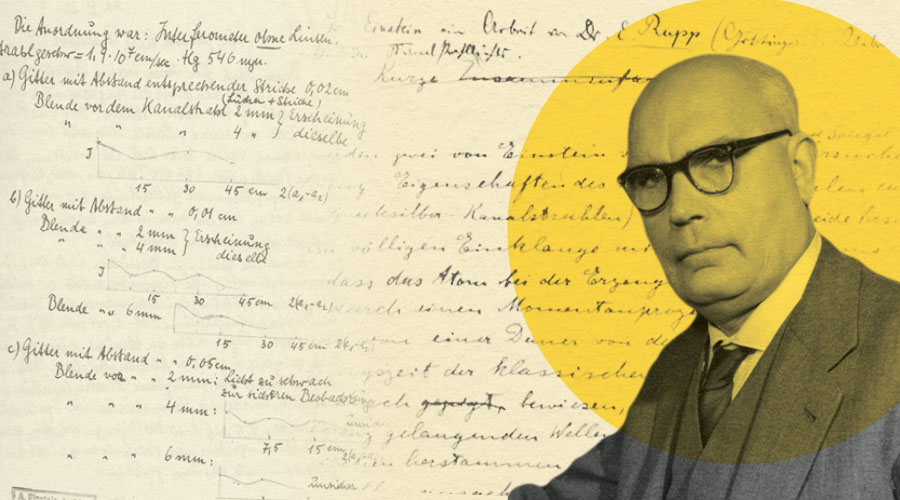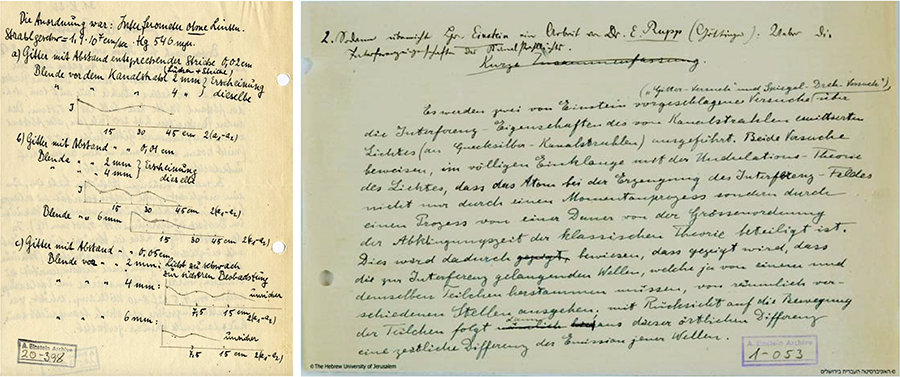December 1934: Emil Rupp’s Research, Which Fooled Even Einstein, is Exposed as Fraud
After Rupp’s rise to prominence for seemingly breakthrough work on canal rays, physicists noticed errors that couldn’t be explained as mere mistakes.
By Tess Joosse | November 14, 2023

Credit: Modified from Emil Rupp’s portrait (Familie Rupp); Rupp’s letter to Einstein, 1926 (©The Hebrew University of Jerusalem, Israel); Rupp’s abstract, written by Einstein (Albert Einstein Archives, the Hebrew University of Jerusalem).
Before Emil Rupp’s misconduct was caught, he had skyrocketed to eminence.
What drives a scientist to lie about their data? When these rare cases bubble up, we reach for explanations: the allure of status, perhaps, or pressure to advance professionally. But in 1935, when German experimentalist Emil Rupp published a notice in the Journal for Physics retracting five papers, he explained away his fraudulence with a note from his physician, Dr. E. Freiherr von Gebsattel:
“… Dr. Rupp had been ill since 1932 with an emotional weakness … During this illness, and under its influence, he has, without being himself conscious of it, published papers on physical phenomena … that have the character of ‘fictions.’ It is a matter of the intrusion of dreamlike states into the area of his scientific activity.”
The retractions marked the end of a career in physics for Rupp, who had, at his peak, won over some of the era’s great scientific minds — including Albert Einstein. “Many might have accepted [Rupp’s] fraudulent results because of Einstein’s endorsement of his experiments,” writes Jeroen van Dongen, a historian of science at the University of Amsterdam. “Moreover, some aspects of Rupp’s work were quite convincing, and … he was rather agile in dealing with the criticisms.”
Born in 1898, Rupp began his career in the 1920s studying canal rays, beams of positive ions and atoms formed between an anode and cathode, the latter punctured with holes (or “canals”), in a gas discharge tube. When these rays shoot through the canals and into a vacuum chamber, the ions rapidly lose and gain charge, emitting visible light that becomes less intense at the other end of the canal.
In his first experiments in the mid-1920s, Rupp measured the coherence length of light — the distance over which the light maintains a consistent phase — emitted by hydrogen and mercury atoms in the canal rays. He measured these lengths as 62 centimeters for hydrogen and 15.2 centimeters for mercury. These were blockbuster results: A moving hydrogen atom was expected to stay coherent over a much smaller distance.
What’s more, Rupp’s extra-long hydrogen canal ray seemed like it could be used to test one of physics’ biggest questions at the time: Is light a particle or a wave? Einstein had devised experiments to test if light was emitted instantaneously or over time, but he needed a light with an extra-long coherence length — and only Rupp had achieved it.
After reading Rupp’s 1926 paper, Einstein published his own “Proposal for an Experiment on the Nature of the Elementary Process of Radiation Emission” and reached out to Rupp directly to discuss a collaboration. But because Rupp’s boss at Heidelberg University, the physicist Philipp Lenard, was “a fervent anti-relativist — and anti-Semite,” writes van Dongen, Einstein chose to forgo a visit to the institution and sent instructions for Rupp to do the experiments on his own.
There were red flags from the start. In one instance, Rupp appeared to have altered the mirrors in his interferometer (the instrument he used to study interference) just so, into an arrangement that would obtain desired outcomes. In another instance, when Einstein corrected the settings Rupp reported using for another instrument, Rupp chalked the mistake up to a typo. There were other “alarming discrepancies” in Rupp’s calculations, van Dongen writes, and Einstein’s letters show that he pushed back on several occasions. Each time, Rupp responded with new results that perfectly explained the oddities Einstein questioned.
Initially, Einstein expected to find that light was emitted instantaneously. But as the collaboration stretched on, he began to expect the experiments would confirm the alternative, the “classical” theory. “One of the reasons for his changing position likely was that that outcome had inadvertently already been corroborated by Rupp,” van Dongen writes.
When Rupp furnished Einstein with a final set of results supporting the classical emission picture, Einstein facilitated their publication in the proceedings of the Prussian Academy of Sciences. They were published back-to-back with a paper by Einstein explaining the theory behind the experiments, in which Einstein cited Rupp’s work. Einstein even helped Rupp draft his paper’s abstract.

Credit: Letter: ©The Hebrew University of Jerusalem, Israel. Abstract: Albert Einstein Archives, the Hebrew University of Jerusalem.
At left, a page of Rupp’s letter to Einstein (1926); at right, the abstract for Rupp's paper, written by Einstein (1926).
The association with Einstein rocketed Rupp to scientific prominence, and in 1928, he accepted a position in the research labs of German electronics company AEG, “a kind of counterpart to General Electric,” writes MIT physicist Anthony French in his 1999 retrospective of Rupp’s case.
However, scientists had begun voicing skepticism about Rupp’s canal ray work. Among them were British spectroscopist Robert d’Escourt Atkinson, who doubted Rupp’s extraordinary coherence lengths, and a researcher named Harald Straub, who tried and failed to replicate Rupp’s measurements in 1930. Rupp came down hard on Straub with a rebuttal, sending photographs that supposedly showed his interference fields and forcefully defending his work in the same journal where Straub published his. Straub wrote that he had nothing else to add, and the matter appeared settled.
But Rupp’s reputation was bruised in the episode, and his letters from the time indicate that his funding at AEG was drying up. He published work on electron scattering, then took up experiments with positrons, producing them by pounding lithium with protons. In a 1934 paper, Rupp claimed to have accelerated protons at potential differences of 500 kV. This was impossible for him to have done — he simply did not have the requisite accelerator in his lab.
In December 1934, two of Rupp’s fellow scientists at AEG brought the glaring problem to the attention of the institute’s director, who launched an investigation and subsequently fired Rupp. In January 1935, Rupp published the retraction statement appended to his doctor’s note, claiming he had no knowledge of or control over the fabrications. And later that year, experimentalists Walther Gerlach and Eduard Rüchardt published “On the Coherence Length of Light emitted by Canal Rays,” which essentially confirmed that Rupp’s early canal ray work was also erroneous. Amid this public humiliation, Rupp experienced a nervous breakdown and spent time in a sanatorium. He never worked in physics again.
Einstein, however, escaped from the episode unscathed. Historians like van Dongen think his credulousness was an honest mistake, underpinned by his desire to see his theories confirmed by experiments. Rupp’s work and life are now a footnote, but following his downfall, it appears that German scientists mentioned his name often. According to French, “for a number of years afterward, the word ‘geruppt’ became an epithet among German physicists to describe questionable work.”
Tess Joosse is a science journalist based in Michigan.
Read more:
November 1887: Granville Woods Patents the Induction Telegraph
September 1936: Seismologist Inge Lehmann Concludes That Earth Has an Inner Core
©1995 - 2024, AMERICAN PHYSICAL SOCIETY
APS encourages the redistribution of the materials included in this newspaper provided that attribution to the source is noted and the materials are not truncated or changed.
Editor: Taryn MacKinney
December 2023/January 2024 (Volume 32, Number 12)
Articles in this Issue

